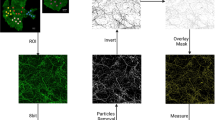Abstract
Functional data indicate that neurons in distinct regions of the heart exert preferential regional cardiac control. To date the regional distribution of specific types of neurons within the intrinsic cardiac nervous system remains unknown, as does their associations with distinct neurotransmitter and/or neuromodulatory profiles. This study was designed to ascertain: (1) the distribution of different classes of neurons within the intrinsic cardiac nervous system as determined by microscopic analysis; (2) the neurochemical profiles of neurons in differing atrial loci; (3) which neurochemicals are co-localized within specific populations of intrinsic cardiac neurons; and (4) the distribution of specific sub-populations of neurons expressing specific immunoreactivities. Taking advantage of confocal laser scanning microscopy and distinct immunoreactive fluorescent markers in various double-label combinations, several sub-populations of intrinsic cardiac neurons were identified. Of all identified neurons, 85–90% were located in ganglia (ganglionic neurons), the rest being isolated (individual neurons). The two general neuronal markers protein gene product 9.5 (PGP 9.5) and microtubule-associated protein (MAP-2) were associated with neurons clustered primarily in the interatrial septum and around the origins of the two vena cavae. Ganglia (group 1) contained three sub-populations of neurons: approx. 80% of ganglionic neurons were large (15–40 µm diameters; group 1a) and approx. 20% had smaller diameters (less than 15 µm; group 1b). All of these neurons were PGP-immunoreactive, exhibiting choline acetyltransferase (ChAT) immunoreactivity (IR), tyrosine hydroxylase (TH) IR, neuropeptide Y (NPY) IR, vasoactive peptide (VIP) IR and substance P (SP) IR. The remaining 5% of ganglionic neurons were small (group 1c; less than 20 µm). These displayed TH immunoreactivity but not MAP, PGP, CHAT, NPY or SP immunoreactivity. Ten to fifteen percent of all neurons loosely distributed outside of ganglia were small (10–25 µm) and located primarily around the origin of the superior vena cava. They displayed immunoreactivity to TH, ChAT, VIP, NPY and SP, but not to MAP-2 or PGP 9.5. These data provide anatomical and immunohistochemical evidence for specific localization of differing populations of intrinsic cardiac neurons with respect to their size, ganglionic distributions and capacity to express multiple neurotransmitters. Although the functional importance of such a regional distribution of differing populations of intrinsic cardiac neurons remains unknown, these anatomical data support the thesis that unique clustering of specific populations of neurons within this nervous system represents the anatomical substrate for complex local cardiac regulatory phenomena occurring at the level of the target organ.
Similar content being viewed by others
Author information
Authors and Affiliations
Additional information
Received: 24 March 1999 / Accepted: 25 March 1999
Rights and permissions
About this article
Cite this article
Horackova, M., Armour, J. & Byczko, Z. Distribution of intrinsic cardiac neurons in whole-mount guinea pig atria identified by multiple neurochemical coding . Cell Tissue Res 297, 409–421 (1999). https://doi.org/10.1007/s004410051368
Issue Date:
DOI: https://doi.org/10.1007/s004410051368




